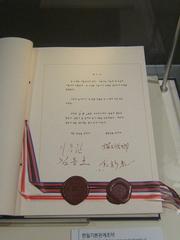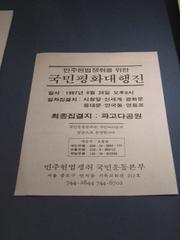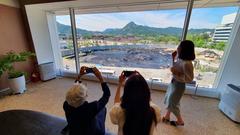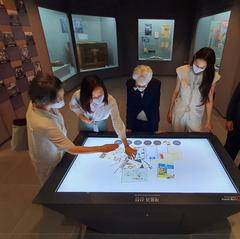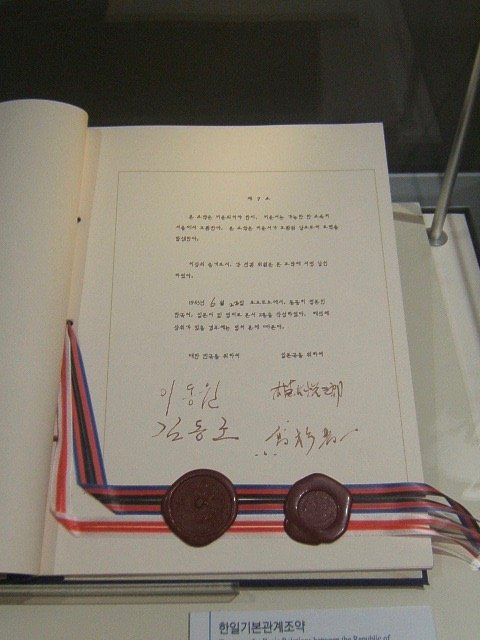
National Museum of Korean Contemporary History: Visiting Hours, Tickets, Exhibitions & Guide to Seoul Historical Sites
Date: 14/06/2025
Introduction
Situated in the vibrant center of Seoul, the National Museum of Korean Contemporary History (NMKCH) is the leading institution dedicated to chronicling Korea’s transformative journey from the late 19th century to the present day. Unlike museums that focus solely on ancient artifacts, NMKCH immerses visitors in Korea’s modern era—covering colonization, liberation, division, rapid industrialization, democratization, and global integration. With a comprehensive array of exhibitions, interactive media, and educational resources, the museum is a must-visit for history enthusiasts, cultural explorers, and families alike.
This guide provides up-to-date information on visiting hours, tickets, accessibility, highlights of the museum’s exhibitions, nearby attractions, and practical tips to ensure a meaningful and engaging visit to one of Seoul’s most significant historical sites (museum.go.kr; National Museum Official Site; Korea JoongAng Daily).
Overview and Significance
The NMKCH was established in December 2012 to provide a dedicated space that traces Korea’s modern history, from the final days of the Joseon Dynasty to its current status as a global leader in culture and technology. Its founding site, formerly the Ministry of Culture, Sports and Tourism, stands near landmark sites such as Gwanghwamun Square and Gyeongbokgung Palace—underscoring its historical and cultural significance.
The museum’s mission is clear: collect, preserve, research, and exhibit artifacts and narratives that illuminate Korea’s path through challenging and dynamic times. By focusing on the modern era, NMKCH plays a vital role in fostering national identity and public understanding of Korea’s development.
Exhibition Highlights
Permanent Exhibition Halls
The museum’s permanent exhibitions, “A Journey Through Modern Korea,” are organized thematically and chronologically across four main halls:
-
Prelude to the Republic of Korea (Late 19th Century–1945):
Explores Korea’s opening to the world, colonial rule, and independence movements. Featured items include the March 1st Declaration of Independence, Gabo Reform artifacts, and personal effects of Ahn Jung-Geun. -
Foundation of the Republic of Korea (1945–1960):
Chronicles Korea’s liberation, division, and the Korean War, with original documents, newsreels, and personal testimonies. -
Development of the Republic of Korea (1960–1987):
Highlights rapid industrialization, urbanization, democratization movements (such as the April Revolution and Gwangju Uprising), and the emergence of pop culture. -
Modernization and Korea’s Vision of the Future (1987–Present):
Showcases Korea’s democratization, technological innovation, the spread of Hallyu (Korean Wave), and efforts toward peace and global integration.
Interactive displays, multimedia installations, and digital reconstructions throughout the halls provide visitors with a multi-sensory and engaging experience.
Special Exhibition Gallery
The museum regularly holds special exhibitions on contemporary themes. For 2025, the headline exhibition is “Re-connect: Until Everyone Is Safe,” which focuses on Korea’s societal response to the COVID-19 pandemic. The exhibition features personal testimonies, artifacts like masks and public health posters, and an interactive digital wall where visitors can share messages of hope (Korea JoongAng Daily).
Upcoming special exhibitions include:
- “Korea’s Path to Democracy: 40 Years Since 1985” (Second half of 2025)
- “Women Shaping Modern Korea” (Late 2025)
Children’s Museum
The museum’s Children’s Museum, “Our History’s Treasure Chest,” offers hands-on activities and interactive exhibits to engage young visitors and families.
Educational Programs and Digital Resources
- Guided Tours: Daily English-language and thematic tours (reservations recommended)
- Workshops: Interactive History Labs, scavenger hunts, and public lectures
- Virtual Tours: Online walkthroughs and downloadable resources for remote learning
- Interactive Timelines: Multimedia presentations of key events in modern Korean history
Visitor Information
Location & Accessibility
-
Address: 198 Sejong-daero, Jongno-gu, Seoul, South Korea
-
Getting There:
- Subway: Gwanghwamun Station (Line 5), Exit 2; 5-minute walk to the museum
- Nearby Landmarks: Gyeongbokgung Palace, Sejong Center for the Performing Arts, Cheonggyecheon Stream
-
Accessibility:
- The museum is fully accessible with elevators, ramps, tactile guides, and accessible restrooms
- Audio guides and exhibition labels are available in Korean, English, Chinese, and Japanese
Visiting Hours & Ticketing
-
Standard Hours: Tuesday to Sunday, 9:00 AM – 6:00 PM; closed Mondays and public holidays
-
Special Exhibitions: Some may have extended hours (e.g., 10:00 AM – 6:00 PM); check current schedules
-
Tickets:
- General admission is free
- Special exhibitions may require advance booking or a nominal fee
- Online reservation for special exhibitions
-
Group Visits:
- Recommended to book in advance for groups of 10 or more
Amenities
- Information desks with multilingual staff
- Lockers and cloakroom
- Free Wi-Fi throughout the facility
- Museum shop and café for refreshments and souvenirs
- Rest areas and rooftop garden with city views
Practical Tips for Your Visit
- Plan Ahead: Check the official website for current exhibitions and events.
- Peak Times: Visit on weekdays or early mornings to avoid crowds.
- Photography: Non-flash photography is allowed in most permanent exhibition areas; check signage for restrictions.
- Duration: Allocate 2–3 hours for a comprehensive visit.
- Guided Experience: Utilize guided tours and audio guides for deeper insight.
Nearby Attractions
Enhance your visit by exploring other historical and cultural sites in the vicinity:
- Gyeongbokgung Palace
- Bukchon Hanok Village
- The Blue House (Cheong Wa Dae)
- Sejong Center for the Performing Arts
- Cheonggyecheon Stream
Frequently Asked Questions (FAQs)
Q: What are the National Museum of Korean Contemporary History visiting hours?
A: Tuesday to Sunday, 9:00 AM – 6:00 PM (closed Mondays and public holidays); check for special exhibition schedules.
Q: Is admission free?
A: Yes, general admission is free. Special exhibitions may require a ticket or reservation.
Q: Is the museum accessible for visitors with disabilities?
A: Yes, facilities are fully accessible with elevators, ramps, tactile guides, and multilingual support.
Q: How can I get tickets for special exhibitions?
A: Reserve online via the museum’s official ticketing page.
Q: Are guided tours available in English?
A: Yes, daily English-language and thematic tours are available; reservations are recommended.
Q: Can I participate in workshops or educational programs?
A: Yes, the museum offers a variety of programs throughout the year for all ages.
Conclusion & How to Stay Updated
The National Museum of Korean Contemporary History offers a rich, multifaceted exploration of Korea’s modern past and present. With its central location, free admission, multilingual resources, and engaging exhibitions, the NMKCH provides an enriching experience for all visitors. Make the most of your trip by planning ahead, taking advantage of guided tours, and visiting nearby cultural landmarks.
Stay informed about exhibitions, events, and educational programs by visiting the official museum website and following NMKCH on social media. For enhanced experiences, download the Audiala app for curated museum guides and audio tours.
Related Articles:
References
- National Museum of Korean Contemporary History official website
- National Museum of Korean Contemporary History English site
- Korea JoongAng Daily – National Museum of Korea special exhibitions
